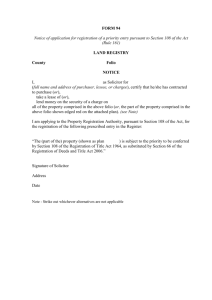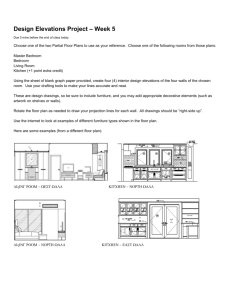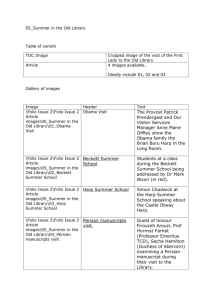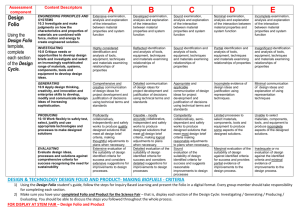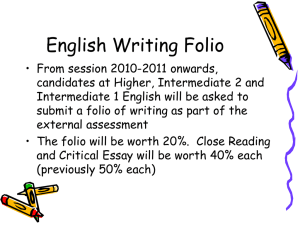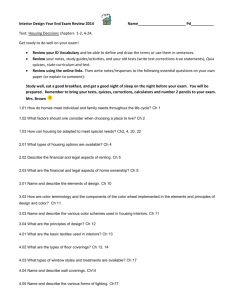Teaching and Learning Program
advertisement
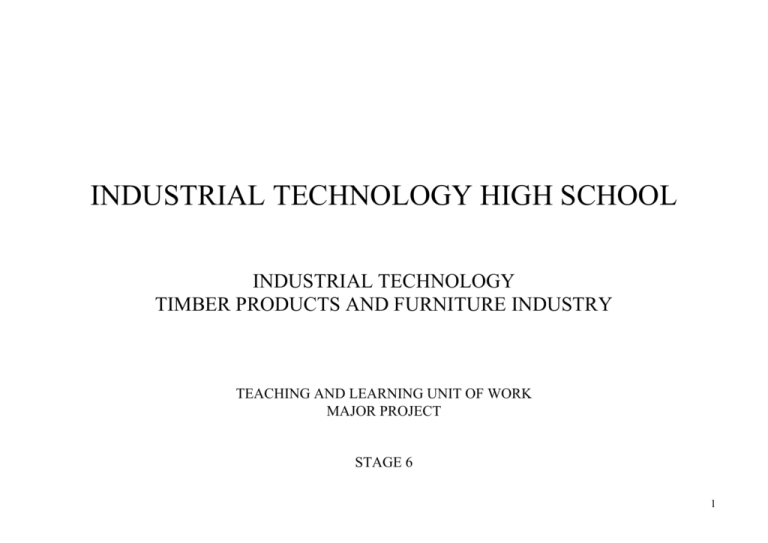
INDUSTRIAL TECHNOLOGY HIGH SCHOOL INDUSTRIAL TECHNOLOGY TIMBER PRODUCTS AND FURNITURE INDUSTRY TEACHING AND LEARNING UNIT OF WORK MAJOR PROJECT STAGE 6 1 HSC COURSE 2 Title: Major Project Timing: 36 weeks Outcomes: A student: H1.1 H1.2 H2.1 H3.1 H3.2 H3.3 H4.1 H4.2 H4.3 H5.1 H5.2 H6.1 H6.2 H7.1 investigates industry through the study of businesses in one focus area identifies appropriate equipment, production and manufacturing techniques and describes the impact of new and developing technologies in industry demonstrates proficiency in the use of safe working practices and workshop equipment maintenance techniques is skilled in sketching, producing and interpreting drawings selects and applies appropriate research and problem-solving skills applies design principles effectively through the production of projects demonstrates competence in practical skills appropriate to the major project explores the need to outsource appropriate expertise where necessary to complement personal practical skills critically applies knowledge and skills related to properties and characteristics of materials/components selects and uses communication and information processing skills selects and applies appropriate documentation techniques to project management evaluates the characteristics of quality manufactured products applies the principles of quality and quality control evaluates the impact of the focus area industry on the social and physical environment 3 Resources: Journals: Australian Wood Review (Issue Number : Page Number) Furniture Makers: David Boucher 3:8 and 14:32, James Bradley 1:36, BVR Furniture 18:24, Les Donges 21:49, Furniture Manufacturing Company of Australia 7:63, Kidman Furniture 1:40, Kitchen Manufacturing 4:73 and 19:72 and software for design 6:32 and 7:66, Helmut Lueckenhausen 3:52, Peter Walker 9:45. Parker Furniture 7:40. Project Ideas and Designs: Various Editions CAD: 2:51, 7:66, 8:90 CNC: 2:54, 3:39, 12:57 Design: 6:73, 8:21, 10:20, 16:41, 17:80, 18:68 Safety: 13:40, 15:36, 16:28, 17:39, 18:72 Videos Red Spot – Design Tech Snapshots (Video) Design and Make It (Video) Furniture Design Parts 1 and 2. VEA Technology at Work - Making Guitars Trees: Who Needs Them VEA Hungry For Profit VEA Radiata Pine Story Produced by the Radiata Pine Association The Timber Industry Classroom Video 1996 Texts Woodwork: Designing, Construction and Workshop Practice. Maynard, J. Halton Educational 1975 Artistic Woodturning Nish, D. Nelson Australia 1984 Woodwork Yarwood, A. Treasure Press 1984 James Krenov, Worker in Wood. Krenov, J. Van Nostrand Reinholdt 1981 Fine Woodworking Techniques. Fine Woodworking Taunton Press 1978-1999 Wood Shop Technics Gray and McCormick Brooks Publishing 1982 Wood and Technology Frange, B. Cambridge University Press 1994 Safety: The Management of Safety at Woodworking Machines … Furnishing Training Australia e-mail mcadam@worksafe.wa.gov.au 4 Students learn about: INDUSTRY STUDY Structural factors organisation and management marketing and sales production and efficiency technology and restructuring quality control Technical factors mechanisation, specialisation mass production and automation emerging technologies Environmental and sociological factors resources, alternatives, limitations recycling pollution government legislation Environmental Impact Studies (EIS) Students learn to: Outcome No: Register Strategies and activities: Prepare a report on the organisation and structure of a range of businesses related to the specific organisation studied in the Preliminary course Identify factors that affect quality control within the industries H1.1 Describes the significance that the various technical factors have in the efficiency of the industries studied H1.2 Students document types of machinery used throughout industries (see Resource List) and their use in production Distinguish between the approaches to the various environmental and sociological factors adopted by each industry studied Discuss and justify the ramifications of Environmental Impact Statements (EIS) and H7.1 Students discuss and document sustainable development and environmental and sociological effects within the focus industry Students to study documentation of various furniture makers and their businesses (Fine Woodworking Magazines) Students to develop comparisons between industry study in Preliminary Course and other furniture makers or related industries 5 Students learn about: Students learn to: sustainable development when studying the overall industry sustainable development Personnel issues industrial relations entry-level training requirements retraining and multiskilling unions roles of industry personnel equity/EEO Occupational health and safety government legislation industry requirements (standards) first aid safety training and human factors materials handling workplace culture Workplace communication DESIGN AND MANAGEMENT Designing research and analysis elements sequence planning material suitability and selection Outcome No: Register Strategies and activities: Describe the personnel issues that businesses have to address in their organisation Identify government legislation and policies that ensure the rights and protection for employees H1.1 Students document personnel issues within the focus industry and the roles of employers and government with respect to EEO Discuss the importance of OH&S factors in a successful business Identify significant government legislation and industry requirements that ensure a safe working environment H3.2 Students to document factors affecting safe working practices and OH & S in industry and classrooms Students to complete worksheets on these issues Explain and justify decisions made during the designing/modifying and planning stages of each project Select appropriate materials and justify decision H6.1 H4.3 H3.3 Students to complete ‘Action/Time/Finance Plan’ for project Students to document in their folio their resources, design ideas, design analysis, modifications to existing designs and materials’ suitability 6 Students learn about: Drawing interpretation sketching production Computer applications computer software related to management and development of folio and project Project management planning documentation WORKPLACE COMMUNICATION Literacy industry terminology written reports materials list management folio computer software – word processing Students learn to: Outcome No: Register Strategies and activities: Refine skills in interpreting and creating drawings relevant to the focus area Prepare all necessary sketches and working drawings required for the production of the major project H3.1 Students undertake sketches and working drawings for their projects Utilise computer software in the development of the management folio H5.1 Students undertake computer graphics and /or word processing, where appropriate, in folio Apply time and finance plans Select and use appropriate industrial processes and equipment Incorporate a range of presentation skills and techniques in the development of the management folio H4.2 H5.1 Teacher discusses with students a variety of presentation techniques that can be used in folio Incorporate the full range of literacy skills in the development of their management folio, Industry study and the production of projects Utilise appropriate word processing in the management H5.1 H5.2 Students to work on Project Folio, inclusive of WP and graphics where appropriate 7 Students learn about: Students learn to: Outcome No: Register Strategies and activities: folio Use appropriate terminology Calculations ordering sizing and quantities costing estimates Graphics reading and interpretation freehand drawing and sketching working drawings computer software graphics signage Competently use current industry standards with all calculations H3.2 Students to calculate material quantities and costs for Major Project Utilise the full range of graphics techniques and standards used in the focus area H3.1 Students to develop design sketches, working drawings and/or plan modifications for project Apply timber industry terms related to selection and sizing Select and use the most appropriate manufactured boards H5.2 Students document in their folios the use of manufactured boards in their projects INDUSTRY-SPECIFIC CONTENT AND PRODUCTION Materials Timber and timber products selection, sizing manufactured boards 8 Students learn about: Fittings and allied materials cabinet hardware composite materials glass, metal, polymers upholstery materials mechanical fasteners adhesives Students learn to: Outcome No: Select and competently use cabinet hardware and mechanical fasteners Competently use and justify the selection of composite materials Select and use the most appropriate adhesives H4.3 Competently perform the range of processes, through practical experiences, which are required for the production work undertaken Select and apply quality finishes Outsource appropriate expertise where necessary to complement personal practical skills H4.1 H4.2 H4.3 H6.2 Select and competently use the most appropriate tools and machinery Recognise the need for and perform maintenance procedures, where necessary, on tools and machinery H2.1 Register Strategies and activities: Students fit appropriate cabinet hardware to their projects. All work is to be justifies and documented in their folios Students undertake processes involved in the construction of their projects, outsourcing where necessary Students apply basic maintenance procedures for workshop equipment Processes, tools and machinery Processes component manufacturing carcase construction framing assembly fabrication laminating finishing Tools and machinery the use and maintenance of the tools and machinery involved in the processes listed above 9 Assessment Week 8, Term 4 (Year 11) Documentation of Statement of Intent and Action/Time/Finance Plan, Design Research, Ideas, Concepts and Preliminary Sketches. Week 4, Term 1 (Year 12) Documentation of suitable drawings (working), design modifications, calculations and industrial processes appropriate for the project. Week 9, Term 1 (Year 12) Progress on Major Project, including quality of work, skills and processes undertaken, degree of difficulty, association with planning folio Week 9, Term 2 (Year 12) Progress on Major Project, documentation of selection and justification of materials, components, resources, communication techniques, consideration given to ethics, sustainable development in material usage and ‘on-going’ evaluation of project. Week 6, Term 3 (Year 12) Trial HSC Week 7, Term 3 (Year 12) Assessment of Major Project. 10
